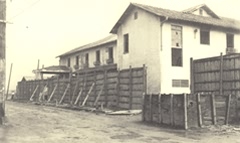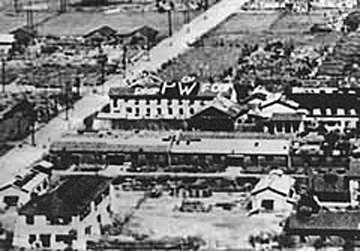Tokyo 5D/Kawasaki
Rosters show the following North China Marines at this camp. They were transferred from Kiangwan in August of 1943. This camp was closed in June of 1945 due to the fire bombings of Tokyo and the men transferred elsewhere. Niigata and Naoetsu seem to have been two camps many of the North China Marines were sent to at that time.
John Beavers, Harold P Brown, Morris Carson, Howard Chittenden, Irv Engler, Walter Freiberger, Ralph Goudy, James Hinkle, Raymond Lease, Eugene Litz, Charles Ludlow, Ronald McMahon, George McShane, Lloyd Parrish, Marvin Ramsey, James Somers, Frank Stockton, Matt Stohlman, William Harold Thomas, and Leslie Troth.
(This camp was originally established in May of 43 with POWs who were apparently from the Philippines. Prisoners were used by the Nippon Steel Tube Company. Nine POWs died here, including Ralph Goudy and Raymond Lease.)
North China Marine Howard Chittenden's book From China Marine to Jap POW describes the camp as one of several in the Tokyo Bay area. It was right across from the main gate of the Kawasaki steel mill. The camp was surrounded by a seven-foot-high fence which contained about two acres and seven buildings. The camp held 250 men. The buildings had a five-foot center aisle and on both sides were the upper and lower sleeping areas, which seems to be the typical barracks layout in Japanese POW camps. (If you go to the Fukuoka 3-B page you can see pictures of this kind of barracks.)The POWs were headed by MSgt Red Kovel from the Army Air Corps in the Philippines, assisted by Charlie Callahan.The Japanese commander was 2nd Lt Ishigi. The senior enlisted man was Sgt Maj Kondo. Chittenden describes him as "a hateful, bitter man" who delighted in striking the POWs.
North China Marine W. H. Thomas describes conditions at this camp as follows:(Written in 1946) In August of 1943 I was moved to Kawasaki, Japan. This camp was ten times as crowded, bamboo mats to sleep on. Sanitary conditions were about the same (as Woosung/Kiangwan). Food less. Most of the time not even an American doctor. Medicine was just something to dream about and the work was in a steel foundry. The punishments there for infractions of camp rules were virtually torture. One of the Japanese methods of administering medicine was to burn nerve centers. Warm clothing and heat was not for the American prisoners. We didn't receive enough soap to keep our bodies clean and would go for months without even a cigarette.A Condo (Kondo) and Omeda at Kawasaki kept food, clothing, and medicine from me. Forced me to work when physically unfit, even while sick. While directly and indirectly under the two above mentioned men I was struck with heavy sticks on the head, stood at attention for hours, forced to go without food etc. for things that absolutely had not any sense or reasoning.For instance - One evening (date forgotten) while the evening meal was under way, Condo walked through the barracks. About thirty minutes later a group of us were called outside. After lining us up he asked us did we have any idea why we were being punished. I said no, which was the truth. Some said yes, they were sent back in the barracks. The remaining men stood at attention while Condo made us a speech (through an interpreter) and worked himself into a rage (typical Japanese-it happened many times). When his rage had culminated he walked down the line of Americans hitting each of us two times on the side of the face with a heavy stick. The reason was for leaning on our blankets while eating. We hadn't any place to eat except our bunks. He wanted us to sit with our legs crossed and backs straight.Another time (about April 30, 1945) we came in from work and were told that every man must be outside at a certain time before eating, line up in an orderly manner and wait. Within an hour we were told that some prisoner had written "V for Victory" on a hospital wall that had been partially destroyed by fire. We would stand at attention until someone admitted the offense. This would be without anything to eat or sleep indefinitely. That night we stood there. The following day we worked without our usual food. Just one small bowl of barley at noon. The second night until 3 a.m. we stood at attention, then a couple of hours sleep. The second day we worked all day on another bowl of barley at noon. The third night we told the Japs that if any of our men did write V for Victory on the hospital we would find out who did it. Something had to be done. Many men had already fainted from fatigue, the rest of us couldn't take it much longer. We were too near starvation as it was. About 1 a.m. the third night a prisoner said he had written the V for Victory. Shortly afterward we were allowed to retire. We never did know for sure whether this man had sacrificed himself for us or not. His suffering continued for several days of barbaric tortures. That was the reason no one had admitted committing the offense. We feared what would follow
.(Howard Chittenden's book, From China Marine to Jap POW, also discusses this incident on pages 163-64. He names North China Marine Ronald McMahon as the man who volunteered to step forward. If both these sources are true McMahon deserves a medal.)
.Red Cross. A Red Cross rep visited our camp in Japan but we could not talk to him. Packages of clothing and toilet articles were opened and the Japanese took some things. A small percentage of boxes were taken.
Mail. After the war was over I received letters that had been held for three years by the Japanese but not distributed (by this time Thomas was in Niigata). I received mail on average of about every six months. The four or five letters I was allowed to send were never received by those I sent them to.
Richard Henry Peterson of the Army Air Corp, captured in the Philippines, has a narrative which can be seen at www.loc.gov/vets/stories/pow-japan.html
Below he discusses conditions at Kawasaki.
He discusses food auctions every night in the barracks. Smokers would trade future bowls of rice or soup for cigarettes. Rats constantly ran around in the barracks at night. The Japanese would commonly have the men line up facing each other and then slap each other in the face. If the POWs did not hit their comrades hard enough the guards would hit them with rifle butts. Men caught stealing would be placed in a wooden box 3 foot by 3 foot by 3 foot after being beaten. They would be kept there for several days. POWs wouild be placed in the sewage pits up to their necks.
During the winter it was too cold to bathe. POWs picked the lice off themselves and crushed them with their fingernails.
Peterson was part of a group being sent to another camp in the spring of 1945. Before he left, North China Marine Matt Stohlman shared a can of Spam he had been saving from one of the few Red Cross packages they received. Peterson said it was one of the best gifts he has ever received. He was an usher at Matt's wedding in Los Angeles in 1946.
Photos below of Kawasaki 5D(Tokyo) from NARA files


Click below to read the diary entries of British Merchant Seaman David Wilson about Kawasaki 5 D and an aerial photo of the camp. Wilson was in the camp at the end of the war. Apparently all POWs were removed after the fire bombings but later some were returned here. If the link does not work copy and paste the following:
www.war-experience.org/collections/sea/alliedbrit/wilson/pagetwo.asp
Click here to see map showing location of Kawasaki 5 D.